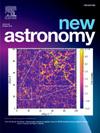Characterizing the spiral Lin–Shu-type density-wave structure of the Milky Way in the 3-kpc-scale solar neighborhood: Astrophysical conclusions
IF 1.9
4区 物理与天体物理
Q2 ASTRONOMY & ASTROPHYSICS
引用次数: 0
Abstract
In the concluding work of a series of studies, the disk’s spiral structure of the Milky Way is anew considered as a Lin–Shu-type density-wave pattern. As a step forward, a sample of stars from a total of 656161 sources within 3 kpc from the Sun and pc from the disk’s mean plane identified in the Gaia EDR3 is examined. The parameters of Galactic rotation and solar peculiar motion corrected for the effects of 3D density waves, and the radial, azimuthal, and vertical components of the streaming motion of stars due to the spiral arms are derived from the measured velocities of objects. The parameters of the waves are also estimated. Two almost equal scales of periodic compression/rarefaction irregularity of the streaming velocity field with the radial and vertical wavelengths of kpc in the form of a spiral density wave propagating in the disk at the Sun are revealed, which are reasonably related to the global spiral pattern. The Sun is located between the central part and the inner edge of the Orion (Local) wave arm. The spiral pattern in the kinematics of stars is consistent with the spatial distribution of the nearby arm segments traced by young populations. In agreement with the original Lin and Shu proposal, the gravitational field associated with the arms is a small deviation from the total gravitational field of the Galaxy that is axisymmetric in the mean. The very existence of the spiral arrangement in the velocity field suggests that the localized disk is gravitationally unstable.
在3kpc尺度的太阳邻域中描述银河系的螺旋林树型密度波结构:天体物理学结论
在一系列研究的结论性工作中,银河系的盘状螺旋结构被重新考虑为林树型密度波模式。作为进一步的研究,我们对来自656161个源的约50万颗恒星样本进行了研究,这些源在距离太阳3 kpc和距离盖亚EDR3确定的圆盘平均平面±250 pc的范围内。由于三维密度波的影响,修正了星系旋转和太阳特殊运动的参数,由于旋臂的影响,恒星流运动的径向、方位角和垂直分量是由测量的物体速度推导出来的。并对波浪的参数进行了估计。揭示了流速度场的两种几乎相等的周期压缩/稀疏不规则尺度,其径向波长和垂直波长均为> 2 kpc,以螺旋密度波的形式在太阳盘中传播,这与全球螺旋模式有合理的关系。太阳位于猎户座(本地)波臂的中心部分和内缘之间。恒星运动学中的螺旋模式与年轻人所追踪到的附近臂段的空间分布是一致的。与Lin和Shu最初的建议一致,与臂相关的引力场与银河系的总引力场有很小的偏差,平均是轴对称的。速度场中螺旋排列的存在表明局域盘是引力不稳定的。
本文章由计算机程序翻译,如有差异,请以英文原文为准。
求助全文
约1分钟内获得全文
求助全文
来源期刊

New Astronomy
地学天文-天文与天体物理
CiteScore
4.00
自引率
10.00%
发文量
109
审稿时长
13.6 weeks
期刊介绍:
New Astronomy publishes articles in all fields of astronomy and astrophysics, with a particular focus on computational astronomy: mathematical and astronomy techniques and methodology, simulations, modelling and numerical results and computational techniques in instrumentation.
New Astronomy includes full length research articles and review articles. The journal covers solar, stellar, galactic and extragalactic astronomy and astrophysics. It reports on original research in all wavelength bands, ranging from radio to gamma-ray.
 求助内容:
求助内容: 应助结果提醒方式:
应助结果提醒方式:


